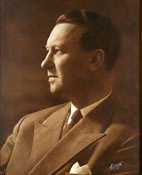H. C. Hansen
| Hans Christian Hansen | |
|---|---|
 | |
| Prime Minister of Denmark | |
|
In office 1 February 1955 – 19 February 1960 (5 years, 18 days) | |
| Monarch | Frederick IX |
| Preceded by | Hans Hedtoft |
| Succeeded by | Viggo Kampmann |
| Personal details | |
| Born |
8 November 1906 Aarhus, Denmark |
| Died |
19 February 1960 (aged 53) Copenhagen |
| Political party | Social Democrats |
Hans Christian Svane Hansen (8 November 1906 – 19 February 1960), often known as H. C. Hansen or simply H. C., was a social democrat and Prime Minister of Denmark from 29 January 1955 to 19 February 1960 as the head of the Cabinet of H. C. Hansen I and II. Before becoming Prime Minister, H. C. Hansen also served as Finance Minister in the Cabinet of Hans Hedtoft I and Foreign Minister in the Cabinet of Hans Hedtoft II. Hansen was trained as a typographer. He was a secretary and later chairman in the Social Democratic Youth and became a member of parliament in 1936.
As Foreign Minister, H. C. Hansen was seen as the natural successor as Prime Minister and leader of the Social Democrats, when his friend Hans Hedtoft died of a heart attack on 29 January 1955. In addition to becoming Prime Minister, H. C. Hansen also retained the post as Foreign Minister until 1958. Amongst the laws passed by this government included the universal people's pension and the enactment of agricultural price supports. The law on assistance to single mothers of April 1955 introduced special assistance for widows with children and certain other categories of single women, while under the Accident Insurance Act of 1959, an independent board of appeal was set up, waiting times were reduced, compensation for survivors was converted from lump sums into running benefits, and the scheme extended to cover occupational diseases. Under a law on relations between trade union a and employers’ associations, passed in April 1956, as an offshoot of collective agreement on the labour market, a new scheme provided sickness cash benefits significantly higher than in the existing health insurance scheme. The new scheme only covered members of trade unions and those employed by members of the Danish Employers’ Association. In addition, under the Apprenticeship Act of September 1956, theoretical training was introduced at technical schools as part of apprenticeship training. In 1956, universal pension coverage in Denmark was introduced, while the Survivors’ Pension Act of March 1959 introduced a general survivors’ pension scheme, including specific provisions for single women having reached age 60. In 1959, a law was enacted that led to the establishment of the Mental Retardation Service and a decentralised regional system of services for those with intellectual disabilities. That same year, an extension of covered occupational diseases in work injury compensation was carried out. In 1958, an education reform was enacted that reduced educational barriers.
In March 1957 it had been 4 years since the last election to the Folketing, and as mandated by the Danish constitution new elections were held. After the election H. C. Hansen was able to partner with the Danish Social Liberal Party and Retsforbundet to form the Cabinet of H.C. Hansen II, also known as the Triangle Cabinet (Trekantsregeringen).
On 25 March 1957 France, West Germany, Italy, Belgium, the Netherlands and Luxembourg signed the Treaty of Rome to create the European Economic Community. To not be left behind the Danish government first wanted to join a Nordic free trade organization, but that failed and Denmark joined the EFTA on 3 May 1960 instead. Unlike his successors as Social Democratic leaders and prime minister, Hansen did not support Denmark joining the European Economic Community that eventually took place in 1972.
H. C. Hansen died from cancer on 19 February 1960, and was succeeded by Viggo Kampmann in the Social Democratic party and as Prime Minister. He was the second Danish prime minister in a row to die while in office.
See also
Footnotes
References
- Kristian Hvidt, Statsministre i Danmark fra 1913 til 1995 (1995)
- Encyclopædia Britannica
- Democratic Socialism: A Global Survey Donald F. Busky
- Growth to Limits: The Western European Welfare States Since World War II, Volume 4 edited by Peter Flora
- https://books.google.co.uk/books?id=c-T9pxsRthMC&pg=PA56&dq=Denmark+universal+pensions+1956&hl=en&sa=X&ei=EvxgVZfcHuiO7AaG6YHQBw&ved=0CD4Q6AEwAg#v=onepage&q=Denmark%20universal%20pensions%20
- https://books.google.co.uk/books?id=F16VaIYewIEC&pg=PA200&dq=26.9.56+%28no.258%29+denmark&hl=en&sa=X&ei=ZsxgVej8Ncq57gbXpoPoBw&ved=0CCEQ6AEwAA#v=onepage&q=26.9.56%20(no.258)%20denmark&f=false
- https://books.google.co.uk/books?id=DM7vy5N7aTIC&pg=PT154&dq=Denmark+Law+on+care+mentally+handicapped+1959&hl=en&sa=X&ei=lv1gVd2uIOKp7AbnvYLABQ&ved=0CFcQ6AEwCTgK#v=onepage&q=Denmark%20Law%20on%20care%20mentally%20handicapped%201959&f=false
- https://books.google.co.uk/books?id=KcM894dMoFcC&pg=PA302&dq=denmark+Unemployment+benefits+substantially+increased+and+indexed+%281967%29&hl=en&sa=X&ei=aYtnVZy1B4a2swGGpICAAg&ved=0CCQQ6AEwAA#v=onepage&q=denmark%20Unemployment%20benefits%20substantially%20increased%20and%20indexed%20(1967)&f=false
- https://books.google.co.uk/books?id=EvYxzGNPrvAC&pg=PA40&dq=denmark+1958+school+years&hl=en&sa=X&ei=RLxcVdK8O8z0UtbYgNAN&ved=0CDgQ6AEwBA#v=onepage&q=denmark%201958%20school%20years&f=false
| Political offices | ||
|---|---|---|
| Preceded by Kristian Hansen Koefoed / none |
Finance Minister of Denmark 5 May 1945 – 7 November 1945 |
Succeeded by Thorkil Kristensen |
| Preceded by Thorkil Kristensen |
Finance Minister of Denmark 13 November 1947 – 16 September 1950 |
Succeeded by Viggo Kampmann |
| Preceded by Jens Otto Krag |
Trade Minister of Denmark 16 September 1950 – 30 October 1950 |
Succeeded by Ove Weikop |
| Preceded by Ole Bjørn Kraft |
Foreign Minister of Denmark 30 September 1953 – 8 October 1958 |
Succeeded by Jens Otto Krag |
| Preceded by Hans Hedtoft |
Prime Minister of Denmark 1 February 1955 – 19 February 1960 |
Succeeded by Viggo Kampmann |
| Party political offices | ||
| Preceded by Hans Hedtoft |
Leader of the Danish Social Democrats 1955–1960 |
Succeeded by Viggo Kampmann |
